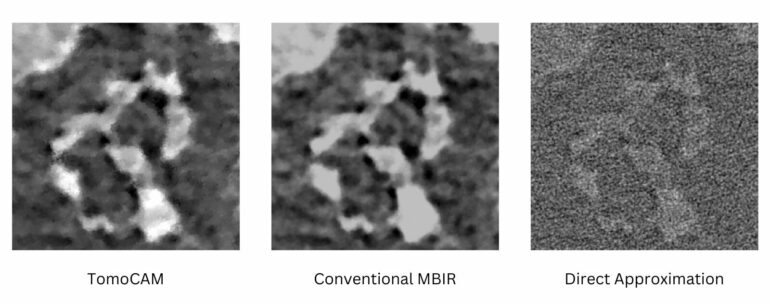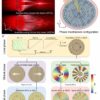Advanced synchrotron tomography is a critical research tool, allowing scientists to explore the intricate structures of objects in extremely high resolution. Because this technique enables researchers to capture dynamics in real-time, it can capture ongoing changes in living organisms (cellular movements and fluid dynamics) for medical research, and in materials, such as observing dendrite formation in batteries to understand the causes of capacity reduction and eventual failure.
The key to this detailed view is that tomography doesn’t just rely on a single X-ray image; instead, multiple images are taken from different angles. These images are then fed into a computer, where mathematical algorithms combine them to produce a three-dimensional (3D) digital representation that reveals an incredibly detailed view of the object’s internal structure.
However, in many cases, the number of images that can be collected is very limited. For example, collecting sufficient images from a rapidly evolving sample can be challenging before it changes shape.
Reconstructing the structure from such limited data is only possible if additional known properties of the sample are included in the data analysis. Unfortunately, modeling these sample properties is often very computationally intensive and may require extensive computational resources that may not be readily available to researchers.
To address this challenge, a team from the Lawrence Berkeley National Laboratory’s (Berkeley Lab’s) Center for Advanced Mathematics for Energy Research Applications (CAMERA), consisting of project scientist Dinesh Kumar and staff scientist Jeffrey Donatelli from the Applied Math and Computational Research Division (AMCR) and staff scientist Dula Parkinson from the Advanced Light Source facility, recently developed a new reconstruction algorithm, TomoCAM, that leverages advanced mathematical techniques and GPU-based computing.
A paper detailing TomoCAM was published in the Journal of Synchrotron Radiation, where it was shown to set a new world record by surpassing the speed of existing state-of-the-art iterative tomographic reconstruction algorithms.
According to Kumar, the paper’s lead author, experimentalists typically use direct approximation methods, such as filtered-back projections (FPB), to do their tomographic reconstructions. However, these direct approximation methods frequently lead to low-quality reconstructions in many experiments where samples are evolving, are susceptible to radiation damage, or the experimental geometry restricts the acquisition of sufficient views.
Alternatively, Model-Based Iterative Reconstruction (MBIR) methods can obtain much higher-quality reconstructions from limited and noisy data. MBIR combines a mathematical model of the tomographic process with educated assumptions about the sample to set up an iterative process.
Starting with an initial guess, a simulated model of the sample is gradually improved to make it simultaneously match the X-ray measurements collected during the experiment and satisfy the sample assumptions. However, the adoption of MBIR has been limited due to the significant computational resources required by conventional implementations.
TomoCAM overcomes these computational cost limitations by reformulating the fundamental operators in MBIR in terms of the sample’s Fourier coefficients, which describe the fundamental frequencies of the sample’s density, similar to the individual notes that make up a piece of music.
These Fourier coefficients can be computed very efficiently using the nonuniform Fast Fourier Transform (NUFFT) algorithm, which allows the MBIR operators in TomoCAM to be computed significantly faster than traditional methods. Additionally, TomoCAM leverages advanced GPU acceleration strategies that optimize data streaming to GPU memory.
These innovations allow TomoCAM to perform MBIR in a fraction of the time compared to traditional MBIR codes while only requiring modest and commonly available computing resources. Furthermore, TomoCAM has a Python front-end, which provides access from Jupyter-based frameworks, enabling straightforward integration into existing workflows at synchrotron facilities.
“It can really make a difference for scientists to see these high-quality results from MBIR so quickly,” said Dula Parkinson, the head scientist for micro-tomography at the ALS.
“TomoCAM allows people to see results from MBIR as they are collecting data much more easily. This enables them to ensure that the combination of experimental and analysis parameters is correct rather than hoping for the best and finding problems later. And it allows them to see the fine details that can guide their decisions about their experimental plan more clearly.”
“The beauty of applied mathematics is that it can often lead to significant performance improvements not possible through high-performance computing alone,” said Jeffrey Donatelli, the Mathematics for Experimental Data Analysis Group lead and deputy director of CAMERA. “By exploiting the mathematical structure of the problem, TomoCAM can significantly accelerate the tomographic inversion process.”
TomoCAM is available to all researchers under an open-source license. Kumar said it is increasingly being used at the ALS, and the National Synchrotron Light Source II at Brookhaven National Laboratory is working to include TomoCAM in their workflow system.
This provides the material science community with the means to expand the scope of tomographic measurements towards increasingly in situ and in operando measurements, where samples are often rapidly evolving and have complex geometries—one example is the investigation of the fractures and deterioration of ceramic matrix composites, which are novel lightweight materials used in jet engines that operate under high temperatures and pressure.
TomoCAM is a continuously evolving product. “We’re looking into new ways to further speed up and automate the tomographic reconstruction pipeline by exploiting additional mathematical structures of the problem and investigating new hybrid methods that leverage machine learning models,” said Kumar.
“The ultimate objective is to lower the entry barrier, speed up the convergence, and simplify the use of MBIR, enabling material scientists to focus on carrying out complex experiments without worrying about the reconstruction process.”
More information:
Dinesh Kumar et al, tomoCAM: fast model-based iterative reconstruction via GPU acceleration and non-uniform fast Fourier transforms, Journal of Synchrotron Radiation (2023). DOI: 10.1107/S1600577523008962
Provided by
Lawrence Berkeley National Laboratory
Citation:
New tomographic reconstruction algorithm sets world record (2024, January 18)



